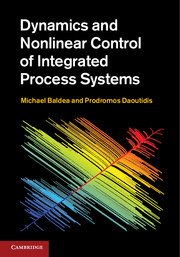Book contents
- Frontmatter
- Contents
- Preface
- Part I Preliminaries
- Part II Process systems with material integration
- 3 Process systems with significant material recycling
- 4 Process systems with purge streams
- 5 Dynamics and control of generalized integrated process systems
- Part III Process systems with energy integration
- Part IV Appendices
- References
- Index
4 - Process systems with purge streams
from Part II - Process systems with material integration
Published online by Cambridge University Press: 05 September 2012
- Frontmatter
- Contents
- Preface
- Part I Preliminaries
- Part II Process systems with material integration
- 3 Process systems with significant material recycling
- 4 Process systems with purge streams
- 5 Dynamics and control of generalized integrated process systems
- Part III Process systems with energy integration
- Part IV Appendices
- References
- Index
Summary
Introduction
The present chapter focuses on the dynamics and control of integrated process systems in which impurities are present in small quantities, e.g., introduced as trace components in feed streams or generated as reaction byproducts. When such impurities are not readily removed by the product streams (e.g., if they are inert or noncondensable), they will accumulate in the process due to material recycling. The accumulation of impurities is detrimental to process operation (causing, for example, catalyst poisoning in the reactor) and process economics (owing to an increase in compression and recirculation costs) (Belanger and Luyben 1998, Luyben 2000, Dimian et al. 2001). Understanding the impact of the presence of impurities on the process dynamics is therefore critical and controlling the level of such components in the recycle structure can be a key operational objective.
In almost all such processes, the flow rate of the purge stream(s) is kept significantly smaller than the process throughput, with the evident goal of minimizing raw-material and product losses and the impact of releasing potentially hazardous chemicals into the environment; the difference between the purge flow rate and the flow rates of other process streams can span a few orders of magnitude. This discrepancy suggests the possibility of a “core” dynamics of the impurity levels in the process evolving in a much slower time scale than the dynamics of the individual process units and possibly the overall process. Developing an explicit nonlinear model of this slow dynamics can be beneficial both for analysis and evaluation purposes, and for model-based control.
- Type
- Chapter
- Information
- Dynamics and Nonlinear Control of Integrated Process Systems , pp. 64 - 101Publisher: Cambridge University PressPrint publication year: 2012



